Attached files
| file | filename |
|---|---|
| 8-K - 8-K - UNITED STATES STEEL CORP | form8-kq42018earningscalls.htm |
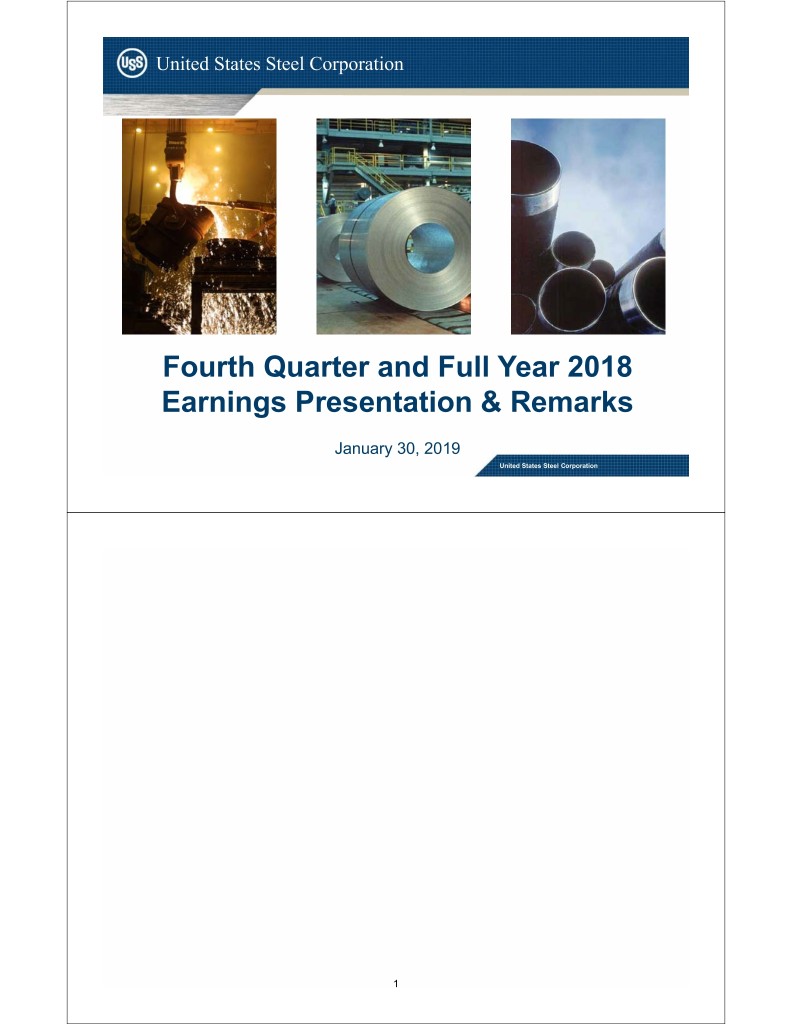
United States Steel Corporation Fourth Quarter and Full Year 2018 Earnings Presentation & Remarks January 30, 2019 United States Steel Corporation 1
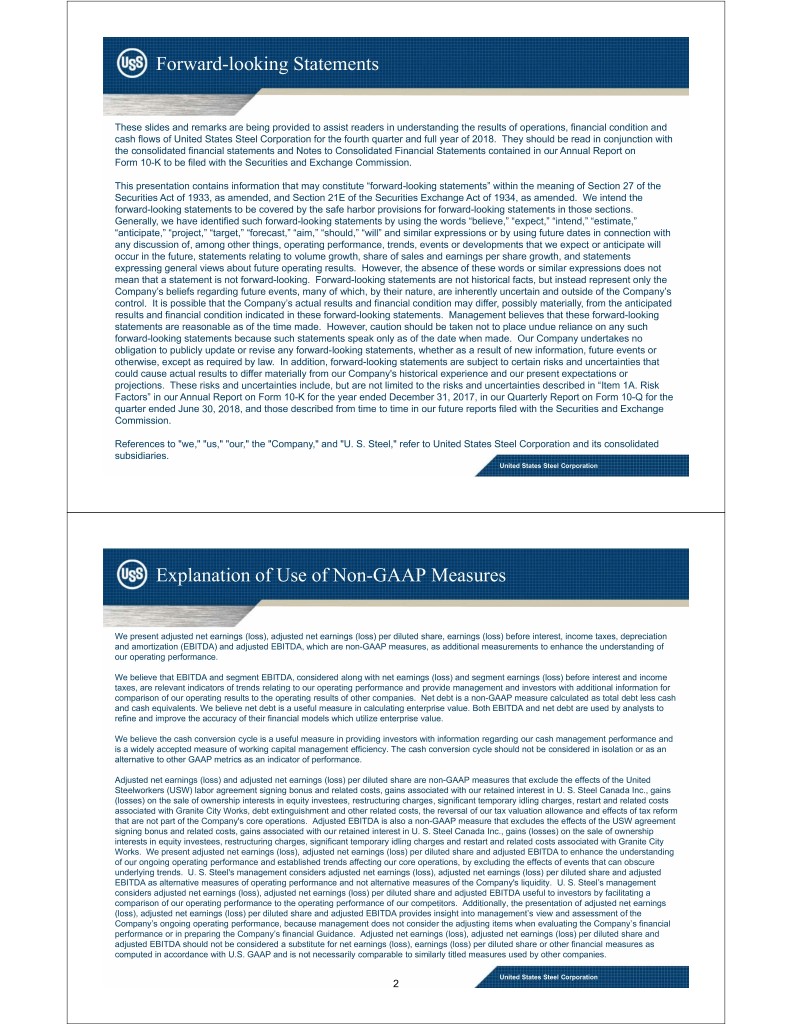
Forward-looking Statements These slides and remarks are being provided to assist readers in understanding the results of operations, financial condition and cash flows of United States Steel Corporation for the fourth quarter and full year of 2018. They should be read in conjunction with the consolidated financial statements and Notes to Consolidated Financial Statements contained in our Annual Report on Form 10-K to be filed with the Securities and Exchange Commission. This presentation contains information that may constitute “forward-looking statements” within the meaning of Section 27 of the Securities Act of 1933, as amended, and Section 21E of the Securities Exchange Act of 1934, as amended. We intend the forward-looking statements to be covered by the safe harbor provisions for forward-looking statements in those sections. Generally, we have identified such forward-looking statements by using the words “believe,” “expect,” “intend,” “estimate,” “anticipate,” “project,” “target,” “forecast,” “aim,” “should,” “will” and similar expressions or by using future dates in connection with any discussion of, among other things, operating performance, trends, events or developments that we expect or anticipate will occur in the future, statements relating to volume growth, share of sales and earnings per share growth, and statements expressing general views about future operating results. However, the absence of these words or similar expressions does not mean that a statement is not forward-looking. Forward-looking statements are not historical facts, but instead represent only the Company’s beliefs regarding future events, many of which, by their nature, are inherently uncertain and outside of the Company’s control. It is possible that the Company’s actual results and financial condition may differ, possibly materially, from the anticipated results and financial condition indicated in these forward-looking statements. Management believes that these forward-looking statements are reasonable as of the time made. However, caution should be taken not to place undue reliance on any such forward-looking statements because such statements speak only as of the date when made. Our Company undertakes no obligation to publicly update or revise any forward-looking statements, whether as a result of new information, future events or otherwise, except as required by law. In addition, forward-looking statements are subject to certain risks and uncertainties that could cause actual results to differ materially from our Company's historical experience and our present expectations or projections. These risks and uncertainties include, but are not limited to the risks and uncertainties described in “Item 1A. Risk Factors” in our Annual Report on Form 10-K for the year ended December 31, 2017, in our Quarterly Report on Form 10-Q for the quarter ended June 30, 2018, and those described from time to time in our future reports filed with the Securities and Exchange Commission. References to "we," "us," "our," the "Company," and "U. S. Steel," refer to United States Steel Corporation and its consolidated subsidiaries. United States Steel Corporation Explanation of Use of Non-GAAP Measures We present adjusted net earnings (loss), adjusted net earnings (loss) per diluted share, earnings (loss) before interest, income taxes, depreciation and amortization (EBITDA) and adjusted EBITDA, which are non-GAAP measures, as additional measurements to enhance the understanding of our operating performance. We believe that EBITDA and segment EBITDA, considered along with net earnings (loss) and segment earnings (loss) before interest and income taxes, are relevant indicators of trends relating to our operating performance and provide management and investors with additional information for comparison of our operating results to the operating results of other companies. Net debt is a non-GAAP measure calculated as total debt less cash and cash equivalents. We believe net debt is a useful measure in calculating enterprise value. Both EBITDA and net debt are used by analysts to refine and improve the accuracy of their financial models which utilize enterprise value. We believe the cash conversion cycle is a useful measure in providing investors with information regarding our cash management performance and is a widely accepted measure of working capital management efficiency. The cash conversion cycle should not be considered in isolation or as an alternative to other GAAP metrics as an indicator of performance. Adjusted net earnings (loss) and adjusted net earnings (loss) per diluted share are non-GAAP measures that exclude the effects of the United Steelworkers (USW) labor agreement signing bonus and related costs, gains associated with our retained interest in U. S. Steel Canada Inc., gains (losses) on the sale of ownership interests in equity investees, restructuring charges, significant temporary idling charges, restart and related costs associated with Granite City Works, debt extinguishment and other related costs, the reversal of our tax valuation allowance and effects of tax reform that are not part of the Company's core operations. Adjusted EBITDA is also a non-GAAP measure that excludes the effects of the USW agreement signing bonus and related costs, gains associated with our retained interest in U. S. Steel Canada Inc., gains (losses) on the sale of ownership interests in equity investees, restructuring charges, significant temporary idling charges and restart and related costs associated with Granite City Works. We present adjusted net earnings (loss), adjusted net earnings (loss) per diluted share and adjusted EBITDA to enhance the understanding of our ongoing operating performance and established trends affecting our core operations, by excluding the effects of events that can obscure underlying trends. U. S. Steel's management considers adjusted net earnings (loss), adjusted net earnings (loss) per diluted share and adjusted EBITDA as alternative measures of operating performance and not alternative measures of the Company's liquidity. U. S. Steel’s management considers adjusted net earnings (loss), adjusted net earnings (loss) per diluted share and adjusted EBITDA useful to investors by facilitating a comparison of our operating performance to the operating performance of our competitors. Additionally, the presentation of adjusted net earnings (loss), adjusted net earnings (loss) per diluted share and adjusted EBITDA provides insight into management’s view and assessment of the Company’s ongoing operating performance, because management does not consider the adjusting items when evaluating the Company’s financial performance or in preparing the Company’s financial Guidance. Adjusted net earnings (loss), adjusted net earnings (loss) per diluted share and adjusted EBITDA should not be considered a substitute for net earnings (loss), earnings (loss) per diluted share or other financial measures as computed in accordance with U.S. GAAP and is not necessarily comparable to similarly titled measures used by other companies. United States Steel Corporation 2

Fourth Quarter and Full Year Financial Highlights Reported Net Earnings Adjusted Net Earnings $ Millions $ Millions $1,115 $957 $592 . Full year net earnings of $1,115 $387 $324 $341 million $159 $136 . Adjusted full year 4Q 2017 4Q 2018 FY 2017 FY 2018 4Q 2017 4Q 2018 FY 2017 FY 2018 EBITDA of $1,760 million Segment EBIT1 Adjusted EBITDA2 $ Millions $ Millions $1,760 . Adjusted 4Q $1,239 EBITDA of $535 $1,148 million $647 $535 $398 $323 $198 4Q 2017 4Q 2018 FY 2017 FY 2018 4Q 2017 4Q 2018 FY 2017 FY 2018 1 Earnings before interest and income taxes 2 Earnings before interest, income taxes, depreciation and amortization United States Steel Corporation Note: For reconciliation of non-GAAP amounts see Appendix. The fourth quarter was another good quarter for us as we generated adjusted EBITDA of $535 million, a $212 million improvement compared to the fourth quarter of 2017. Our full year adjusted EBITDA of $1.76 billion included $1.25 billion from our Flat-Rolled segment, resulting from strong commercial conditions and the benefit from running at higher utilization rates. In 2018, we continued executing investments in our people and our assets as we work towards our objective of achieving operational excellence through a focus on safety, quality, delivery, and cost. We believe that executing well in these areas is the foundation for long term success and value creation. We are focused on the pillars of operational excellence – safety, quality, delivery, and cost, and are confident that improving our performance in these key areas will help us: . Create value for our stockholders, as well as all other U. S. Steel stakeholders, including employees, customers, suppliers, and the communities in which we operate . Develop distinct competitive advantages and solutions for our customers . Achieve success through business cycles . Drive predictable, sustainable and increased profitability in the future, including reinvestment in our business that provides returns in excess of our cost of capital 3
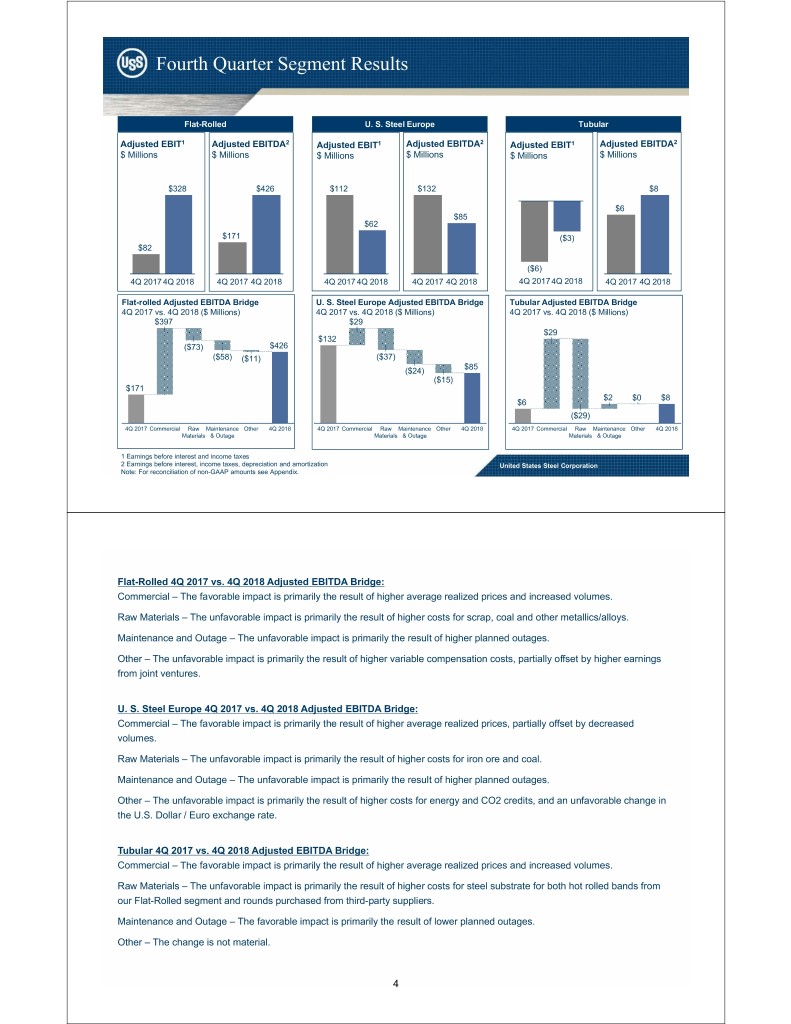
Fourth Quarter Segment Results Flat-Rolled U. S. Steel Europe Tubular Adjusted EBIT1 Adjusted EBITDA2 Adjusted EBIT1 Adjusted EBITDA2 Adjusted EBIT1 Adjusted EBITDA2 $ Millions $ Millions $ Millions $ Millions $ Millions $ Millions $328 $426 $112 $132 $8 $6 $85 $62 $171 ($3) $82 ($6) 4Q 2017 4Q 2018 4Q 2017 4Q 2018 4Q 2017 4Q 2018 4Q 2017 4Q 2018 4Q 2017 4Q 2018 4Q 2017 4Q 2018 Flat-rolled Adjusted EBITDA Bridge U. S. Steel Europe Adjusted EBITDA Bridge Tubular Adjusted EBITDA Bridge 4Q 2017 vs. 4Q 2018 ($ Millions) 4Q 2017 vs. 4Q 2018 ($ Millions) 4Q 2017 vs. 4Q 2018 ($ Millions) $397 $29 $29 $132 ($73) $426 ($58) ($11) ($37) $85 ($24) ($15) $171 $2 $0 $8 $6 ($29) 4Q 2017 Commercial Raw Maintenance Other 4Q 2018 4Q 2017 Commercial Raw Maintenance Other 4Q 2018 4Q 2017 CommercialRaw Maintenance Other 4Q 2018 Materials & Outage Materials & Outage Materials & Outage 1 Earnings before interest and income taxes 2 Earnings before interest, income taxes, depreciation and amortization United States Steel Corporation Note: For reconciliation of non-GAAP amounts see Appendix. Flat-Rolled 4Q 2017 vs. 4Q 2018 Adjusted EBITDA Bridge: Commercial – The favorable impact is primarily the result of higher average realized prices and increased volumes. Raw Materials – The unfavorable impact is primarily the result of higher costs for scrap, coal and other metallics/alloys. Maintenance and Outage – The unfavorable impact is primarily the result of higher planned outages. Other – The unfavorable impact is primarily the result of higher variable compensation costs, partially offset by higher earnings from joint ventures. U. S. Steel Europe 4Q 2017 vs. 4Q 2018 Adjusted EBITDA Bridge: Commercial – The favorable impact is primarily the result of higher average realized prices, partially offset by decreased volumes. Raw Materials – The unfavorable impact is primarily the result of higher costs for iron ore and coal. Maintenance and Outage – The unfavorable impact is primarily the result of higher planned outages. Other – The unfavorable impact is primarily the result of higher costs for energy and CO2 credits, and an unfavorable change in the U.S. Dollar / Euro exchange rate. Tubular 4Q 2017 vs. 4Q 2018 Adjusted EBITDA Bridge: Commercial – The favorable impact is primarily the result of higher average realized prices and increased volumes. Raw Materials – The unfavorable impact is primarily the result of higher costs for steel substrate for both hot rolled bands from our Flat-Rolled segment and rounds purchased from third-party suppliers. Maintenance and Outage – The favorable impact is primarily the result of lower planned outages. Other – The change is not material. 4

Full Year Segment Results Flat-Rolled U. S. Steel Europe Tubular Adjusted EBIT1 Adjusted EBITDA2 Adjusted EBIT1 Adjusted EBITDA2 Adjusted EBIT1 Adjusted EBITDA2 $ Millions $ Millions $ Millions $ Millions $ Millions $ Millions $883 $1,250 $359 $446 $327 $403 $727 ($11) $375 ($58) ($99) ($48) FY 2017 FY 2018 FY 2017 FY 2018 FY 2017 FY 2018 FY 2017 FY 2018 FY 2017 FY 2018 FY 2017 FY 2018 Flat-rolled Adjusted EBITDA Bridge U. S. Steel Europe Adjusted EBITDA Bridge Tubular Adjusted EBITDA Bridge FY 2017 vs. FY 2018 ($ Millions) FY 2017 vs. FY 2018 ($ Millions) FY 2017 vs. FY 2018 ($ Millions) $1,085 $149 $130 $25 $446 ($314) $1,250 $403 ($86) ($45) ($180) ($68) $727 $10 ($88) ($11) ($15) ($48) FY 2017 CommercialRaw Maintenance Other FY 2018 FY 2017 Commercial Raw Maintenance Other FY 2018 FY 2017 Commercial Raw Maintenance Other FY 2018 Materials & Outage Materials & Outage Materials & Outage 1 Earnings before interest and income taxes 2 Earnings before interest, income taxes, depreciation and amortization United States Steel Corporation Note: For reconciliation of non-GAAP amounts see Appendix. Flat-Rolled FY 2017 vs. FY 2018 Adjusted EBITDA Bridge: Commercial – The favorable impact is primarily the result of higher average realized prices and increased volumes. Raw Materials – The unfavorable impact is primarily the result of higher costs across all raw materials categories. Maintenance and Outage – The unfavorable impact is primarily the result of higher planned outages. Other – The unfavorable impact is primarily the result of higher variable compensation costs, partially offset by higher earnings from joint ventures and lower energy costs. U. S. Steel Europe FY 2017 vs. FY 2018 Adjusted EBITDA Bridge: Commercial – The favorable impact is primarily the result of higher average realized prices, partially offset by decreased volumes. Raw Materials – The unfavorable impact is primarily the result of higher costs across all raw materials categories. Maintenance and Outage – The unfavorable impact is primarily the result of higher planned outages. Other – The favorable impact is primarily the result of a favorable change in the U.S. Dollar / Euro exchange rate, partially offset by higher costs for energy and CO2 credits. Tubular FY 2017 vs. FY 2018 Adjusted EBITDA Bridge: Commercial – The favorable impact is primarily the result of higher average realized prices and increased volumes. Raw Materials – The unfavorable impact is primarily the result of higher costs for steel substrate for both hot rolled bands from our Flat-Rolled segment and rounds purchased from third-party suppliers. Maintenance and Outage – The unfavorable impact is primarily the result of higher planned outages. Other – The favorable impact is primarily due to lower variable compensation and increased earnings from joint ventures. 5
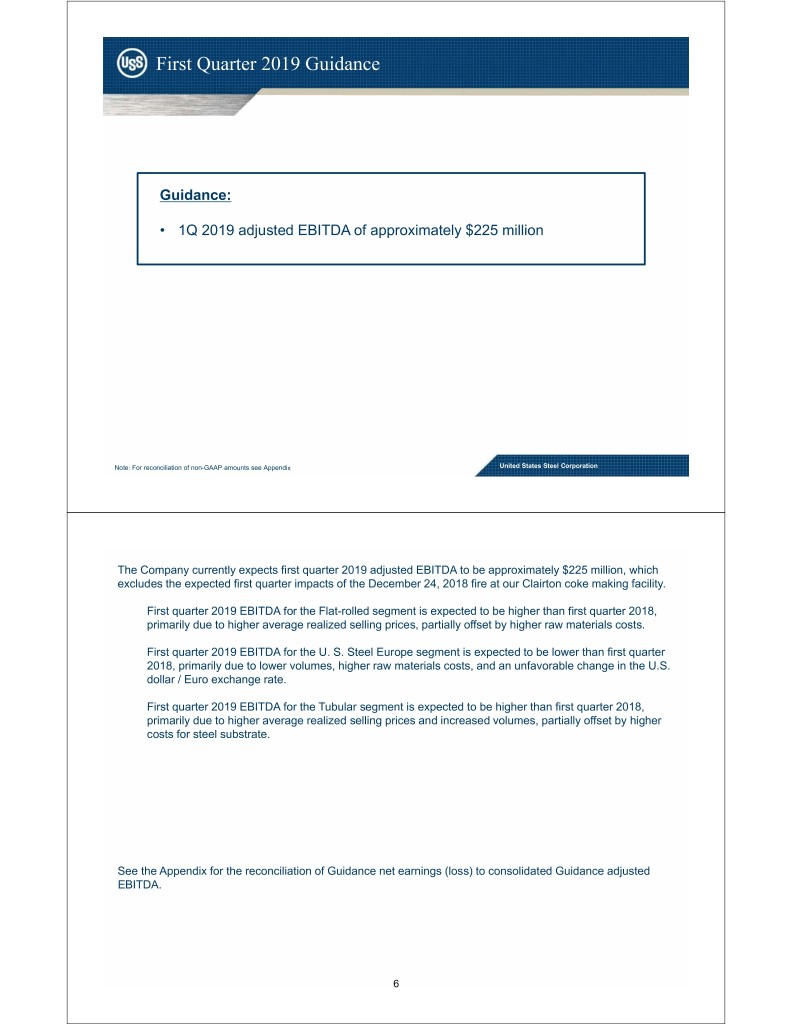
First Quarter 2019 Guidance Guidance: • 1Q 2019 adjusted EBITDA of approximately $225 million Note: For reconciliation of non-GAAP amounts see Appendix United States Steel Corporation The Company currently expects first quarter 2019 adjusted EBITDA to be approximately $225 million, which excludes the expected first quarter impacts of the December 24, 2018 fire at our Clairton coke making facility. First quarter 2019 EBITDA for the Flat-rolled segment is expected to be higher than first quarter 2018, primarily due to higher average realized selling prices, partially offset by higher raw materials costs. First quarter 2019 EBITDA for the U. S. Steel Europe segment is expected to be lower than first quarter 2018, primarily due to lower volumes, higher raw materials costs, and an unfavorable change in the U.S. dollar / Euro exchange rate. First quarter 2019 EBITDA for the Tubular segment is expected to be higher than first quarter 2018, primarily due to higher average realized selling prices and increased volumes, partially offset by higher costs for steel substrate. See the Appendix for the reconciliation of Guidance net earnings (loss) to consolidated Guidance adjusted EBITDA. 6

2019 Full Year Projections Operating Metrics Income Statement Cash Flow Statement Flat-rolled segment: Depreciation, Depletion and Capital Spending: Amortization: ‒ Estimated shipment volume to 2019 estimate: approximately $1,200 million third party customers of 2019 estimate: approximately $570 million approximately 11.5 million tons Pension and Other Benefits Cash Pension and Other Benefits Costs: Payments1 : U. S. Steel Europe segment: 2019 estimate: approximately $215 million ‒ Estimated shipment volume to 2019 estimate: approximately $125 million • approximately $123 million in EBITDA third party customers of • approximately $92 million in net interest approximately 4.0 – 4.2 million Cash Interest Expense: and other financial costs tons 2019 estimate: approximately $150 million Others Costs: Tubular segment: ‒ Flat-rolled segment annual fixed ‒ Estimated shipment volume of price metallurgical coal contracts up approximately 0.8 – 0.9 million approximately $20 per ton of coal tons compared to 2018 ‒ U. S. Steel Europe segment increased costs for purchased CO2 credits of approximately $20 million compared to 2018 1Excluding voluntary pension contributions United States Steel Corporation We are modifying our guidance methodology going forward by adopting guidance practices used by other companies in our sector. As a transition to new guidance practices, we are providing first quarter quantitative guidance. However, in future quarters, we will be providing quantitative guidance during the last month of the quarter. In addition to our first quarter quantitative guidance, we are providing full year projections for several operating metrics, as well as income statement and cash flow statement items that we believe will be helpful for investors and analysts. We expect full year 2019 shipments for the Flat-rolled segment to be approximately 11.5 million tons, up from 10.5 million tons in 2018, reflecting the full year availability from Granite City, partially offset by higher planned outages at Gary Works, Great Lakes Works and Mon Valley Works related to our asset revitalization program. We expect full year 2019 shipments for the U. S. Steel Europe segment to be approximately 4.0 million to 4.2 million tons, down from 4.5 million tons in 2018, primarily reflecting higher planned outages at our blast furnaces and steel shops and decreased demand for semi-finished product. We expect full year 2019 shipments for the Tubular segment to be approximately 0.8 million to 0.9 million tons, slightly up from 0.8 million tons in 2018. 7
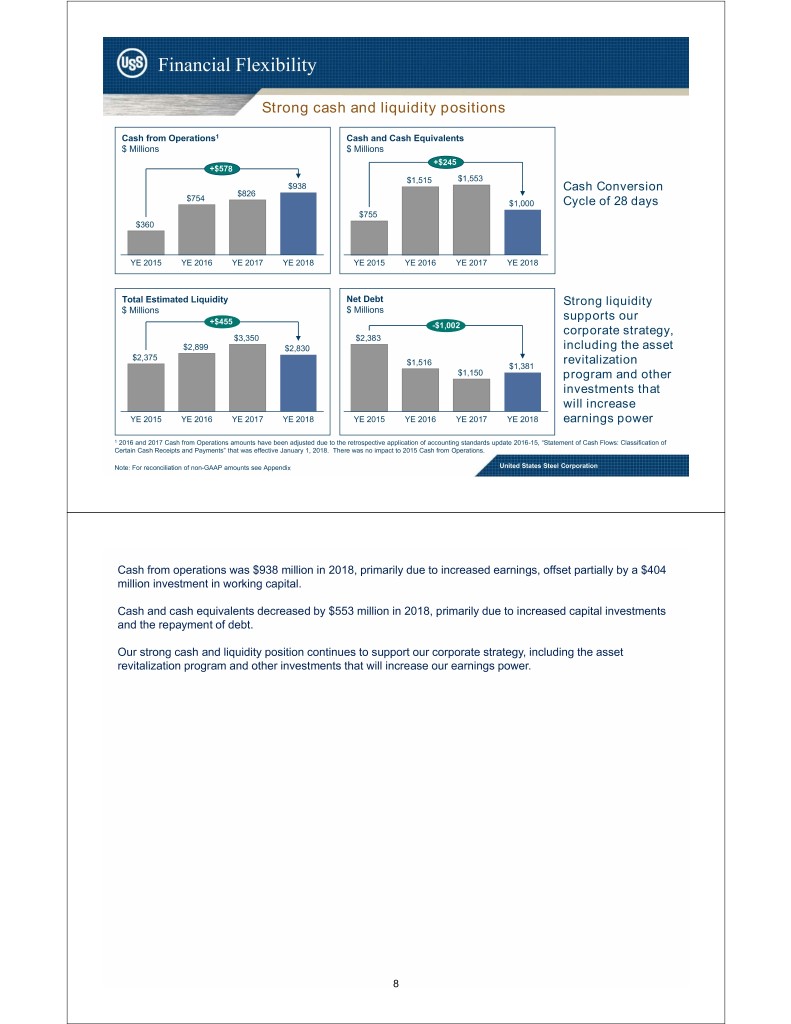
Financial Flexibility Strong cash and liquidity positions Cash from Operations1 Cash and Cash Equivalents $ Millions $ Millions +$245 +$578 $1,515 $1,553 $938 Cash Conversion $826 $754 $1,000 Cycle of 28 days $755 $360 YE 2015YE 2016 YE 2017 YE 2018 YE 2015YE 2016 YE 2017 YE 2018 Total Estimated Liquidity Net Debt Strong liquidity $ Millions $ Millions +$455 supports our -$1,002 corporate strategy, $3,350 $2,383 $2,899 $2,830 including the asset $2,375 revitalization $1,516 $1,381 $1,150 program and other investments that will increase YE 2015 YE 2016 YE 2017 YE 2018 YE 2015 YE 2016 YE 2017 YE 2018 earnings power 1 2016 and 2017 Cash from Operations amounts have been adjusted due to the retrospective application of accounting standards update 2016-15, “Statement of Cash Flows: Classification of Certain Cash Receipts and Payments” that was effective January 1, 2018. There was no impact to 2015 Cash from Operations. Note: For reconciliation of non-GAAP amounts see Appendix United States Steel Corporation Cash from operations was $938 million in 2018, primarily due to increased earnings, offset partially by a $404 million investment in working capital. Cash and cash equivalents decreased by $553 million in 2018, primarily due to increased capital investments and the repayment of debt. Our strong cash and liquidity position continues to support our corporate strategy, including the asset revitalization program and other investments that will increase our earnings power. 8
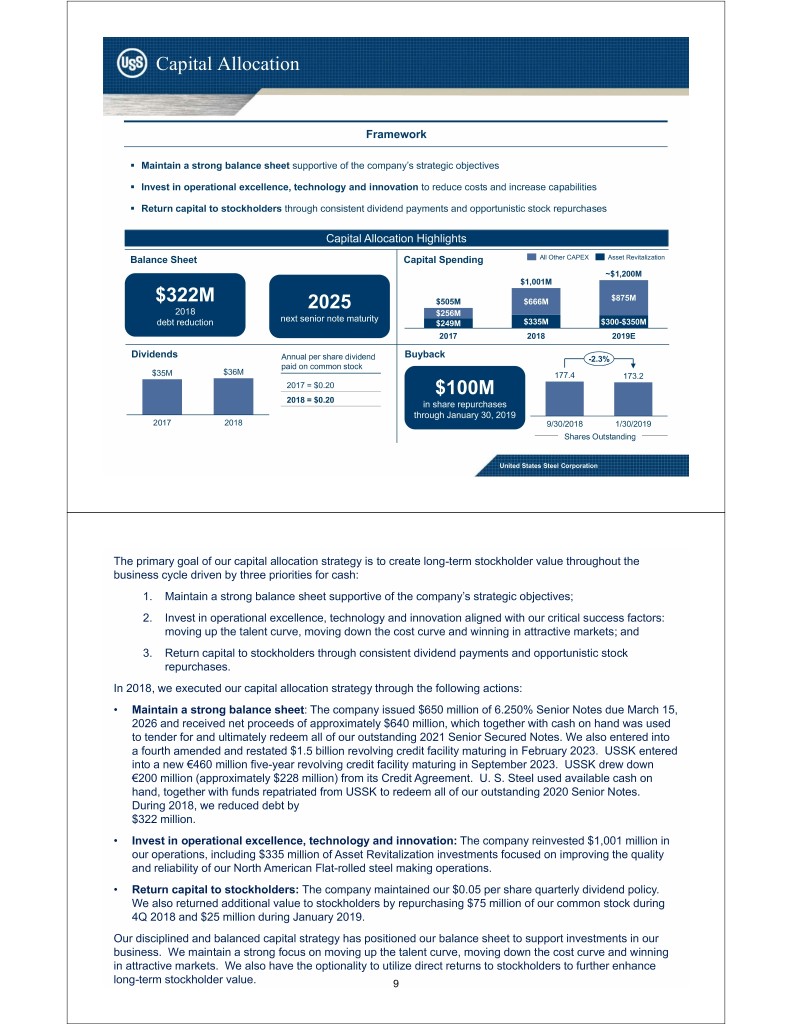
Capital Allocation Framework . Maintain a strong balance sheet supportive of the company’s strategic objectives . Invest in operational excellence, technology and innovation to reduce costs and increase capabilities . Return capital to stockholders through consistent dividend payments and opportunistic stock repurchases Capital Allocation Highlights Balance Sheet Capital Spending All Other CAPEX Asset Revitalization ~$1,200M $1,001M $322M 2025 $505M $666M $875M 2018 $256M next senior note maturity debt reduction $249M $335M $300-$350M 20172018 2019E Dividends Annual per share dividend Buyback -2.3% paid on common stock $35M $36M 177.4 173.2 2017 = $0.20 $100M 2018 = $0.20 in share repurchases through January 30, 2019 2017 2018 9/30/2018 1/30/2019 Shares Outstanding United States Steel Corporation The primary goal of our capital allocation strategy is to create long-term stockholder value throughout the business cycle driven by three priorities for cash: 1. Maintain a strong balance sheet supportive of the company’s strategic objectives; 2. Invest in operational excellence, technology and innovation aligned with our critical success factors: moving up the talent curve, moving down the cost curve and winning in attractive markets; and 3. Return capital to stockholders through consistent dividend payments and opportunistic stock repurchases. In 2018, we executed our capital allocation strategy through the following actions: • Maintain a strong balance sheet: The company issued $650 million of 6.250% Senior Notes due March 15, 2026 and received net proceeds of approximately $640 million, which together with cash on hand was used to tender for and ultimately redeem all of our outstanding 2021 Senior Secured Notes. We also entered into a fourth amended and restated $1.5 billion revolving credit facility maturing in February 2023. USSK entered into a new €460 million five-year revolving credit facility maturing in September 2023. USSK drew down €200 million (approximately $228 million) from its Credit Agreement. U. S. Steel used available cash on hand, together with funds repatriated from USSK to redeem all of our outstanding 2020 Senior Notes. During 2018, we reduced debt by $322 million. • Invest in operational excellence, technology and innovation: The company reinvested $1,001 million in our operations, including $335 million of Asset Revitalization investments focused on improving the quality and reliability of our North American Flat-rolled steel making operations. • Return capital to stockholders: The company maintained our $0.05 per share quarterly dividend policy. We also returned additional value to stockholders by repurchasing $75 million of our common stock during 4Q 2018 and $25 million during January 2019. Our disciplined and balanced capital strategy has positioned our balance sheet to support investments in our business. We maintain a strong focus on moving up the talent curve, moving down the cost curve and winning in attractive markets. We also have the optionality to utilize direct returns to stockholders to further enhance long-term stockholder value. 9

Flat-Rolled Segment Asset Revitalization Program Significant Execution and Progress EBITDA improvement Capital Spending1 $ Millions $ Millions $275- $125-$150M $1.5B $325M $75-$100M $111M $275-$325M $335M $300-$350M 2018 2018 2019 2020 2018 2018 2019 Total Target Actual Target Exit_Rate Target Actual Target Program Quality2 Reliability (including Unplanned Maintenance Downtime) % Improvement vs. 2016 Base % Improvement vs. 2016 Base 16% 16% 19% 20% 12% +25% 8% +16% 2018 2018 2019 2020 2018 2018 2019 2020 End of End of End of End of End of End of End of End of Year Year Year Year Year Year Year Year Target Actual Target Target Target Actual Target Target 1Total Asset Revitalization program is $2.0 billion, comprised of $1.5 billion of capital and $0.5 billion of expense. 2The quality metric has been adjusted to account for significant planned outages. Applying the same adjustment, the 2017 end of year quality metric performance improved 13% from the base period compared to the 9% improvement previously reported. United States Steel Corporation We have developed a performance scorecard that includes two financial (EBITDA and capital expenditures) and two non-financial (quality and reliability) metrics for tracking our progress on implementing our Flat-rolled segment asset revitalization program. Our progress through 2018 towards our 2020 goals are illustrated on the scorecard above. We continued to make good progress in 2018 on our asset revitalization program and exceeded the scorecard targets we had committed to for 2018. We have now set our 2019 targets for each of these metrics and are focused on achieving our goals. EBITDA benefits as a result of asset revitalization investments totaled $111 million. Benefits include operational impacts achieved through asset improvement and the commercial impact of additional throughput as a result of our investments. The program is measured against our 2016 performance as a base period, assuming 2016 raw material costs and adjusting for other market factors such as inflation, changes in product mix, and changes in outage durations versus the base period. We currently expect a 2019 EBITDA benefit of $125 - $150 million and we are on track to achieve the program’s target of 15-20% IRR. We invested $335 million of capital in 2018 related to the asset revitalization program, and we expect $300 - $350 million of asset revitalization-related capital investment in 2019. Our project execution remains on track. Our capital investments of $584 million over the first two years of our asset revitalization program have resulted in improved performance, both operationally and with our customers. The level of improvement we have achieved in the first two years makes us increasingly confident that we will deliver the projected EBITDA benefits and IRR targets. 10
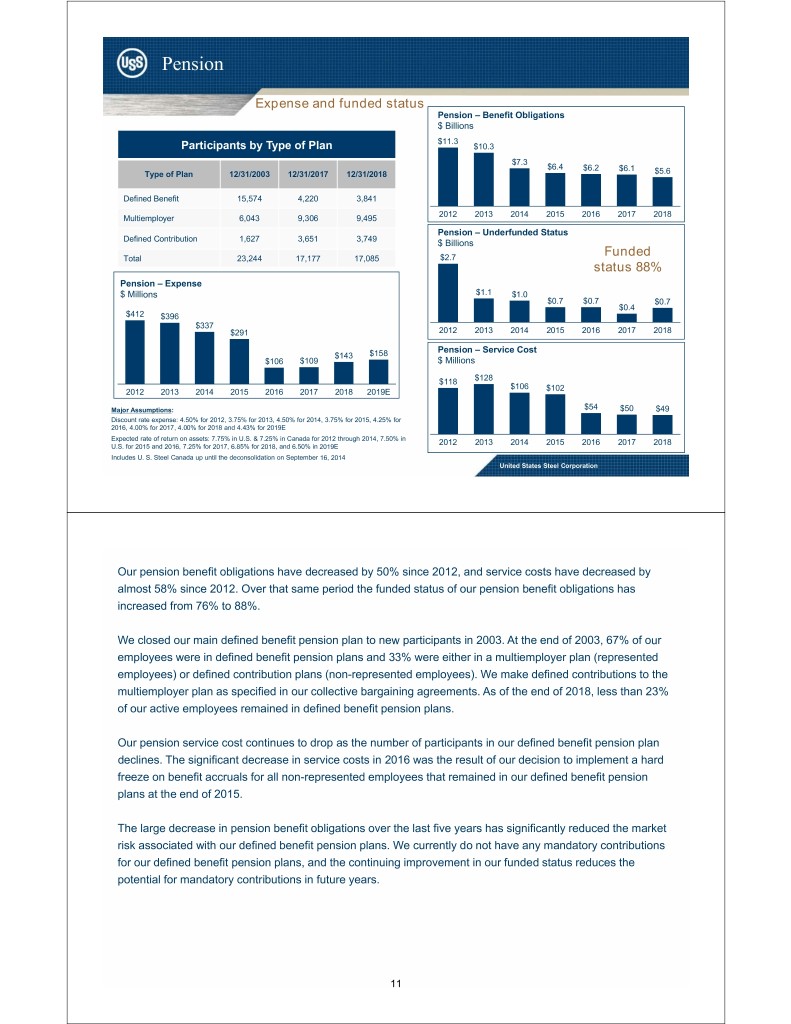
Pension Expense and funded status Pension – Benefit Obligations $ Billions $11.3 Participants by Type of Plan $10.3 $7.3 $6.4 $6.2 $6.1 Type of Plan 12/31/2003 12/31/2017 12/31/2018 $5.6 Defined Benefit 15,574 4,220 3,841 2012201320142015 2016 2017 2018 Multiemployer 6,043 9,306 9,495 Pension – Underfunded Status Defined Contribution 1,627 3,651 3,749 $ Billions Funded Total 23,244 17,177 17,085 $2.7 status 88% Pension – Expense $ Millions $1.1 $1.0 $0.7 $0.7 $0.7 $0.4 $412 $396 $337 $291 20122013 20142015 2016 2017 2018 Pension – Service Cost $143 $158 $106 $109 $ Millions $118 $128 $106 2012 201320142015 2016 2017 2018 2019E $102 Major Assumptions: $54 $50 $49 Discount rate expense: 4.50% for 2012, 3.75% for 2013, 4.50% for 2014, 3.75% for 2015, 4.25% for 2016, 4.00% for 2017, 4.00% for 2018 and 4.43% for 2019E Expected rate of return on assets: 7.75% in U.S. & 7.25% in Canada for 2012 through 2014, 7.50% in 2012 20132014 2015 2016 2017 2018 U.S. for 2015 and 2016, 7.25% for 2017, 6.85% for 2018, and 6.50% in 2019E Includes U. S. Steel Canada up until the deconsolidation on September 16, 2014 United States Steel Corporation Our pensionFinancial benefit obligations Flexibility have decreased by 50% since 2012, and service costs have decreased by almost 58% since 2012. Over that same period the funded status of our pension benefit obligations has increased from 76% to 88%. We closed our main defined benefit pension plan to new participants in 2003. At the end of 2003, 67% of our employees were in defined benefit pension plans and 33% were either in a multiemployer plan (represented employees) or defined contribution plans (non-represented employees). We make defined contributions to the multiemployer plan as specified in our collective bargaining agreements. As of the end of 2018, less than 23% of our active employees remained in defined benefit pension plans. Our pension service cost continues to drop as the number of participants in our defined benefit pension plan declines. The significant decrease in service costs in 2016 was the result of our decision to implement a hard freeze on benefit accruals for all non-represented employees that remained in our defined benefit pension plans at the end of 2015. The large decrease in pension benefit obligations over the last five years has significantly reduced the market risk associated with our defined benefit pension plans. We currently do not have any mandatory contributions for our defined benefit pension plans, and the continuing improvement in our funded status reduces the potential for mandatory contributions in future years. 11

OPEB Expense and funded status OPEB – Expense OPEB – Benefit Obligations $ Millions $ Billions $100 $78 $3.9 $55 $60 $57 $3.4 $2.7 $2.4 $2.4 $2.3 $2.1 -$5 -$25 -$40 20122013 2014 2015 2016 2017 2018 2019E 2012 2013 2014 20152016 2017 2018 OPEB – Service Cost OPEB – Underfunded Status $ Millions $ Billions Funded $28 $27 $2.2 status 88% $22 $21 $20 $17 $17 $1.4 $0.6 $0.4 $0.3 $0.3 $0.3 20122013 2014 20152016 2017 2018 2012 2013 2014 2015 2016 2017 2018 Major Assumptions: Discount rate expense: 4.50% for 2012, 3.75% for 2013, 4.50% for 2014, 3.75% for 2015, 4.25% for 2016, 4.00% for 2017, 4.03% 2018, and 4.47% for 2019E Expected rate of return on assets: 7.75% in U.S. & 7.25% in Canada for 2012 through 2014, 7.50% in U.S. for 2015 and 2016, 3.25% for 2017, 4.25% for 2018 and 2019E Includes U. S. Steel Canada up until the deconsolidation on September 16, 2014 United States Steel Corporation Our OPEBFinancial benefit obligations Flexibility have decreased by almost 46% since 2012, and service costs have decreased by 40% since 2012. Over that same period, the funded status of our OPEB benefit obligations has improved from 44% to 88%. The funded status reflects a fully funded Voluntary Employees’ Beneficiary Association Trust (VEBA) as described below, partially offset by other unfunded retiree medical and life obligations. In 1994, we created a VEBA to hold assets to be used to fund future retiree healthcare and life insurance benefits. Over the years, through a combination of company contributions and investment returns, our VEBA assets have grown to approximately $2 billion dollars, and are greater than the associated liabilities. We have a reasonable degree of certainty regarding the future cash outflows from the VEBA to pay retiree benefits. Based on the overfunded status of the VEBA, significant exposure to equities is not prudent and in 2016 we took steps to invest in high quality corporate and government bonds whose maturities approximate the projected cash outflows of the VEBA, essentially eliminating the risk to the company of having to make future contributions to the VEBA. 12

Appendix © 2011 United States Steel Corporation United States Steel Corporation Operating Update Iron ore mining facilities At our iron ore mining operations, we are operating both our Minntac and Keetac facilities to meet our current domestic steel making needs and support our third party pellet sales. Flat-Rolled steel making and finishing facilities We continue to operate the steel making and finishing facilities at our Gary, Great Lakes, and Mon Valley Works. We began shipping steel from the restarted “B” blast furnace and steel making facilities at Granite City Works on June 13 and resumed production from the “A” blast furnace on October 3. We continue to operate the hot strip mill and finishing facilities at our Granite City Works and continue to operate the finishing facilities at our Fairfield, Midwest, East Chicago, and Fairless Hills locations. U. S. Steel Europe Our USSE operations are running at high levels with production affected by planned outages at our blast furnaces and steel shops. Tubular facilities We are currently operating our seamless mills in Fairfield, AL and Lorain, OH. Our seamless mill in Fairfield produces mid-range diameter pipe, while our Lorain #3 mill produces large diameter pipe that is historically used for off-shore drilling. We are currently purchasing rounds from third parties to feed our seamless mills. We restarted our Lone Star #2 welded pipe mill in late April 2017. United States Steel Corporation 13

Flat-Rolled Segment Sources: Wards / AHAM / Prestons / Customer Reports / AISI / US Census Bureau / Platts-FWDodge / Dept of Commerce / AIA / NAHB / MSCI Major end markets summary December light vehicle sales beat forecasts at 17.51 million sales SAAR; full year sales were the fourth best ever at 17.22 million vehicles, exceeding 17 million for 4 consecutive years. Truck, SUV and CUV sales remain robust, Automotive with over 70% market share; 2019 sales projected to stay strong. January vehicle inventories decreased by 11 days to 61 days of supply, the same as the year ago level. Industrial After a 2018 that realized material increases in business, heavy equipment manufacturers are suggesting that 2019 is projected to be another strong year of similar demand across most of the industries they service. Railcar Equipment business should improve in 2019, led by increased demand in hopper car production. Through October, domestic mill shipments are essentially flat compared to the 2017 pace. Year-to-date imports of Tin Plate tin mill products through November licenses have decreased 15%; when compared with flat domestic shipments; this suggests lower apparent demand in 2018. December appliance unit shipments increased 3.3% year-over-year, and showed an 18% increase above Appliance November. 2018 major appliance shipments finished within 0.6% of the record 47.6 million units of 2017. AHAM forecasts for 2019 and 2020 suggest growth of 2.7% and 1.6% respectively. Rig counts have been rangebound between 1,070 – 1,080 for about 2 months. With high extraction rates Pipe continuing, demand for OCTG remains firm at levels similar to full year 2017. Imports are on pace to finish 17% lower based on November license detail. Line pipe demand remains robust as 2019 awarded projects remain high and Tube and numerous projects are out to bid. Dodge’s November square footage assessment totaled 304 million, up 7% from November 2017. After a robust November, the December Architectural Billing Index fell to 50.4 but still expanding for the fifteenth consecutive Construction month. The Dodge Momentum Index, a non-residential construction measure, declined 4.9% to 151.9 from November, but averaged 4.3% higher in 2018 largely due to a strong first half. Service MSCI ship tons per day fell in December for the fourth consecutive month to 88,200 tons per day. December was 0.5% higher than the year end 2017. Coated products saw the largest decrease month-over-month. Center Months supply of inventory increased 0.6 months to 3.0, the highest since the end of 2015. United States Steel Corporation U. S. Steel Europe Segment Sources: Eurofer, USSK Marketing, IHS, Eurometal, Euroconstruct Major end markets summary EU car production reached 4.6 million units in 4Q, a decrease of 4% year-over-year. EU car production is projected to fall by 2.4% year-over-year in 1Q 2019 to 4.9 million units. In 2018, car production reached 18.6 million units, a decrease of 1.6% year-over-year. An increase of 0.7% year-over-year to Automotive 18.7 million units is currently projected for 2019. Total V4 car production reached 0.94 million units in 4Q, an increase of 8% year-over-year. V4 car production is anticipated to increase by 4.2% year-over-year in 1Q 2019 to 0.95 million units. V4 car production increased by 1.8% year-over-year in 2018 to 3.5 million units and 2019 car production is projected to grow by 2.5% year-over-year to 3.6 million units. EU appliance sector production increased by 0.2% year-over-year in 4Q. Overall, a 1.2% year-over-year growth is expected in 2018. In 1Q 2019, production is expected to increase by 0.9% year-over-year. In 2019, the appliance market is projected to grow by 1.9% year-over-year. In 4Q, Central Europe Appliance decreased by 0.1% year-over-year and is expected to decline by 0.6% year-over-year. In 1Q 2019, an increase of 0.6% is expected year-over-year. Overall, the Central European sector is projected to grow by 2.2% year-over-year in 2019. Tin consumption in the EU continued to decrease in 4Q and demand fell by 1.6% year-over-year. 2018 Tin Plate is expected to be flat compared to last year. Inventories are elevated and 1Q 2019 bookings reflect weaker demand. The total construction output has increased by 2.8% in 2018. New residential construction and new civil engineering have been the major drivers of growth. In 2019, due to worsening of economic conditions in Construction the EU and due to downward revision of growth forecasts, the construction sector is expected to grow only marginally or remain stagnate. Service The latest data showed that November SSC inventory moved down slightly from October’s peak. Inventory levels remain high, indicating the potential for a continued slowdown in buying. Industry Centers sources are reporting that beginning of year inventory levels are high. United States Steel Corporation 14
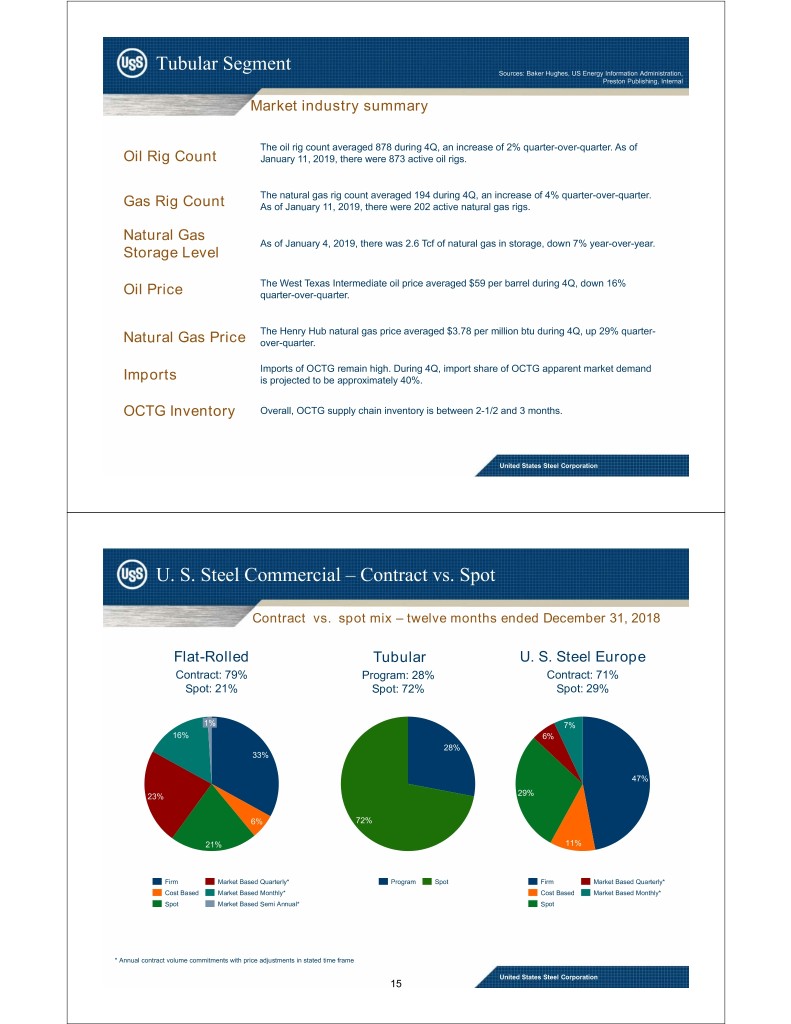
Tubular Segment Sources: Baker Hughes, US Energy Information Administration, Preston Publishing, Internal Market industry summary The oil rig count averaged 878 during 4Q, an increase of 2% quarter-over-quarter. As of Oil Rig Count January 11, 2019, there were 873 active oil rigs. The natural gas rig count averaged 194 during 4Q, an increase of 4% quarter-over-quarter. Gas Rig Count As of January 11, 2019, there were 202 active natural gas rigs. Natural Gas As of January 4, 2019, there was 2.6 Tcf of natural gas in storage, down 7% year-over-year. Storage Level The West Texas Intermediate oil price averaged $59 per barrel during 4Q, down 16% Oil Price quarter-over-quarter. The Henry Hub natural gas price averaged $3.78 per million btu during 4Q, up 29% quarter- Natural Gas Price over-quarter. Imports of OCTG remain high. During 4Q, import share of OCTG apparent market demand Imports is projected to be approximately 40%. OCTG Inventory Overall, OCTG supply chain inventory is between 2-1/2 and 3 months. United States Steel Corporation U. S. Steel Commercial – Contract vs. Spot Contract vs. spot mix – twelve months ended December 31, 2018 Flat-Rolled Tubular U. S. Steel Europe Contract: 79% Program: 28% Contract: 71% Spot: 21% Spot: 72% Spot: 29% 1% 7% 16% 6% 28% 33% 47% 23% 29% 6% 72% 21% 11% Firm Market Based Quarterly* Program Spot Firm Market Based Quarterly* Cost Based Market Based Monthly* Cost Based Market Based Monthly* Spot Market Based Semi Annual* Spot * Annual contract volume commitments with price adjustments in stated time frame United States Steel Corporation 15

Third Quarter 2018 vs. Fourth Quarter 2018 Flat-Rolled segment EBITDA Bridge Commercial – The unfavorable impact is primarily the result of lower average 3Q 2018 vs. 4Q 2018 ($ Millions) realized prices, partially offset by increased volumes. $21 $426 $392 $19 $20 Raw Materials – The favorable impact is primarily the result of lower costs for scrap and other metallics/alloys. ($26) Maintenance and Outage – The favorable impact is primarily the result of lower planned outages. Other – The favorable impact is primarily the result of higher earnings from joint 3Q 2018 Commercial Raw Materials Maintenance Other 4Q 2018 ventures. & Outage U. S. Steel Europe segment EBITDA Bridge Commercial – The favorable impact is primarily the result of higher average 3Q 2018 vs. 4Q 2018 ($ Millions) realized prices, partially offset by decreased volumes. Raw Materials – The unfavorable impact is primarily the result of higher costs $18 $6 $95 $85 for iron ore. ($13) ($21) Maintenance and Outage – The favorable impact is primarily the result of lower planned outages. Other – The unfavorable impact is primarily the result of higher costs for energy 3Q 2018 Commercial Raw Materials Maintenance Other 4Q 2018 and CO2 credits, and an unfavorable change in the U.S. Dollar / Euro exchange & Outage rate. Tubular segment EBITDA Bridge Commercial – The unfavorable impact is primarily the result of lower average 3Q 2018 vs. 4Q 2018 ($ Millions) realized prices, partially offset by increased volumes. $18 Raw Materials – The unfavorable impact is primarily the result of higher costs for hot rolled bands from our Flat-Rolled segment. $4 ($4) $8 Maintenance and Outage – The favorable impact is primarily the result of ($7) ($3) lower planned outages. 3Q 2018 Commercial Raw Materials Maintenance Other 4Q 2018 Other – The unfavorable impact is primarily the result of higher variable & Outage compensation. Note: For reconciliation of non-GAAP amounts see Appendix. United States Steel Corporation Total Corporation Total Corporation Adjusted EBITDA Bridge Total Corporation Adjusted EBITDA Bridge 4Q 2017 vs. 4Q 2018 ($ Millions) 4Q 2017 vs. 4Q 2018 ($ Millions) $455 $255 $2 $2 $535 ($47) ($139) $535 ($80) ($24) $323 $323 4Q 2017 Commercial Raw Materials Maintenance Other 4Q 2018 4Q 2017 Flat-Rolled U. S. Steel Tubular Other 4Q 2018 & Outage Europe Businesses Total Corporation Adjusted EBITDA Bridge Total Corporation Adjusted EBITDA Bridge 2017 vs. 2018 ($ Millions) 2017 vs. 2018 ($ Millions) $1,364 $9 $1,760 $523 $43 $37 $1,760 ($488) $1,148 ($240) ($24) $1,148 2017 Commercial Raw Materials Maintenance Other 2018 2017Flat-RolledU. S. Steel Tubular Other 2018 & Outage Europe Businesses Note: For reconciliation of non-GAAP amounts see Appendix. United States Steel Corporation 16

Reconciliation of segment EBITDA Segment EBITDA – Flat-Rolled 4Q 2017 3Q 2018 4Q 2018 FY 2017 FY 2018 ($ millions) Segment earnings before interest and income taxes $82 $305 $328 $375 $883 Depreciation 89 87 98 352 367 Segment EBITDA $171 $392 $426 $727 $1,250 Segment EBITDA – U. S. Steel Europe 4Q 2017 3Q 2018 4Q 2018 FY 2017 FY 2018 ($ millions) Segment earnings before interest and income taxes $112 $72 $62 $327 $359 Depreciation 20 23 23 76 87 Segment EBITDA $132 $95 $85 $403 $446 Segment EBITDA – Tubular 4Q 2017 3Q 2018 4Q 2018 FY 2017 FY 2018 ($ millions) Segment loss before interest and income taxes ($6) $7 ($3) ($99) ($58) Depreciation 12 11 11 51 47 Segment EBITDA $6 $18 $8 ($48) ($11) United States Steel Corporation Reconciliation to Consolidated 1Q Adjusted EBITDA Included in Guidance ($ millions) 1Q 2019 Projected net loss attributable to United States Steel Corporation included in Guidance ($6) Estimated income tax benefit (1) Estimated net interest and other financial costs 57 Estimated depreciation, depletion and amortization 135 Projected EBITDA included in Guidance $185 Expected first quarter impact of the December 24, 2018 fire at the Clairton coke making facility 40 Projected adjusted EBITDA included in Guidance $225 United States Steel Corporation 17
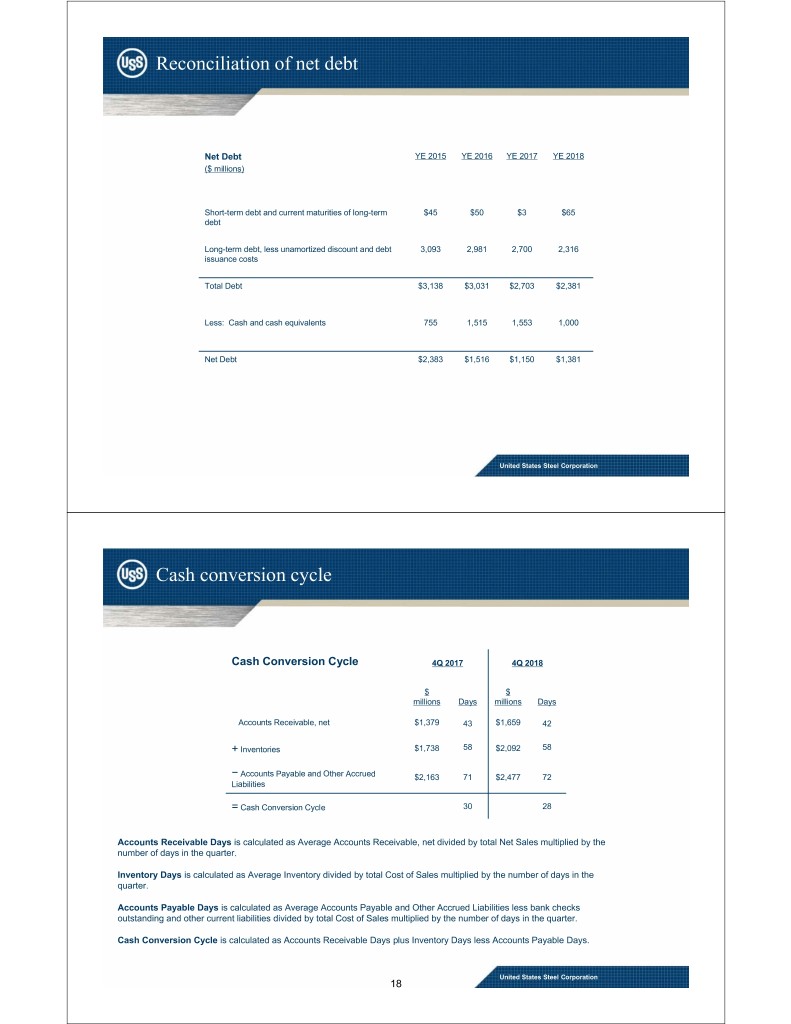
Reconciliation of net debt Net Debt YE 2015 YE 2016 YE 2017 YE 2018 ($ millions) Short-term debt and current maturities of long-term $45 $50 $3 $65 debt Long-term debt, less unamortized discount and debt 3,093 2,981 2,700 2,316 issuance costs Total Debt $3,138 $3,031 $2,703 $2,381 Less: Cash and cash equivalents 755 1,515 1,553 1,000 Net Debt $2,383 $1,516 $1,150 $1,381 United States Steel Corporation Cash conversion cycle Cash Conversion Cycle 4Q 2017 4Q 2018 $ $ millions Days millions Days Accounts Receivable, net $1,379 43 $1,659 42 + Inventories $1,738 58 $2,092 58 − Accounts Payable and Other Accrued $2,163 71 $2,477 72 Liabilities = Cash Conversion Cycle 30 28 Accounts Receivable Days is calculated as Average Accounts Receivable, net divided by total Net Sales multiplied by the number of days in the quarter. Inventory Days is calculated as Average Inventory divided by total Cost of Sales multiplied by the number of days in the quarter. Accounts Payable Days is calculated as Average Accounts Payable and Other Accrued Liabilities less bank checks outstanding and other current liabilities divided by total Cost of Sales multiplied by the number of days in the quarter. Cash Conversion Cycle is calculated as Accounts Receivable Days plus Inventory Days less Accounts Payable Days. United States Steel Corporation 18

Reconciliation of reported and adjusted net earnings ($ millions) 4Q 2017 4Q 2018 2017 2018 Reported net earnings attributable to U. S. Steel $159 $592 $387 $1,115 United Steelworkers labor agreement signing bonus and related costs ─ 88 ─ 81 Reversal of tax valuation allowance ─ (374) ─ (374) Gain associated with retained interest in U. S. Steel Canada Inc. ─ ─ (72) ─ Loss (gain) on equity investee transactions 19 (20) (2) (38) Loss on shutdown of certain tubular pipe mill assets ─ ─ 35 ─ Loss on debt extinguishment and other related costs 22 21 57 101 Effect of tax reform (81) ─ (81) ─ Granite City Works restart and related costs ─ 17 ─ 80 Granite City Works temporary idling charges 17 ─ 17 (8) Adjusted net earnings attributable to U. S. Steel $136 $324 $341 $957 Note: The adjustments included in the table have been tax effected at a 0% rate due to the recognition of a full valuation allowance on our domestic deferred tax assets. United States Steel Corporation Reconciliation of adjusted EBITDA 4Q 2017 3Q 2018 4Q 2018 2017 2018 ($ millions) Reported net earnings attributable to U. S. Steel $159 $291 $592 $387 $1,115 Income tax (benefit) provision (89) 23 (339) (86) (303) Net interest and other financial costs1 92 59 60 368 312 Reported earnings before interest and income taxes $162 $373 $313 $669 $1,124 Depreciation, depletion and amortization expense 125 126 137 501 521 EBITDA $287 $499 $450 $1,170 $1,645 United Steelworkers labor agreement signing bonus and ──88─ 81 related costs Gain associated with retained interest in ─ ─ ─ (72) ─ U. S. Steel Canada Inc. Loss (gain) on equity investee transactions 19 ─ (20) (2) (38) Granite City Works restart and related costs ─ 27 17 ─ 80 Loss on shutdown of certain tubular assets ─ ─ ─ 35 ─ Granite City Works temporary idling charges 17 ─ ─ 17 (8) Adjusted EBITDA $323 $526 $535 $1,148 $1,760 1Net interest and other financial costs amounts were adjusted due to the retrospective application of accounting standards update 2017-07, “Compensation-Retirement Benefits” that was effective January 1, 2018. United States Steel Corporation 19
